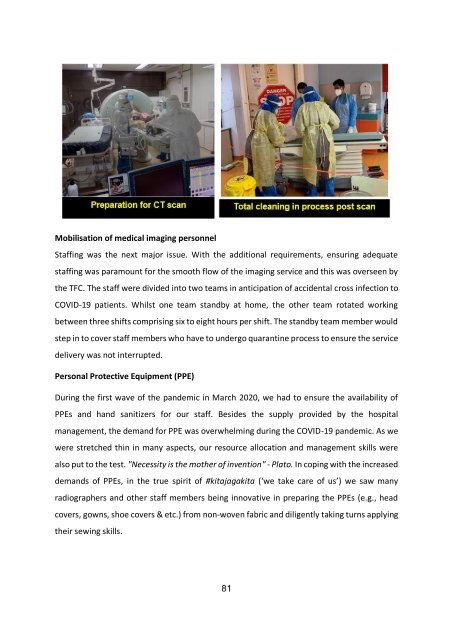ISRRT_COVID-19_book
Create successful ePaper yourself
Turn your PDF publications into a flip-book with our unique Google optimized e-Paper software.
As radiographers, we are one of the first lines of health professionals that require regular<br />
contact with suspected, probable, or confirmed <strong>COVID</strong>-<strong>19</strong> patient presenting with respiratory<br />
symptoms requiring imaging. As such, radiographers are more predisposed to the <strong>COVID</strong>-<strong>19</strong><br />
virus. This has naturally heightened the radiographers’ fear and anxiety level and is more so<br />
with information and control strategies frequently evolving as new evidence becomes known<br />
on the virus.<br />
Role of medical imaging and services: breaking the boundaries<br />
Imaging plays a critical role in <strong>COVID</strong>-<strong>19</strong> patient management. Imaging examinations, typically<br />
chest X-rays and computed tomography (CT) scans of the chest are essential in assessing the<br />
severity and progression of <strong>COVID</strong>-<strong>19</strong>. When medical imaging is required, radiographers play<br />
a vital role in performing and producing optimum quality images to assist decision making in<br />
the clinical diagnosis, management, and treatment of <strong>COVID</strong>-<strong>19</strong> patients.<br />
One of the most significant challenges associated with the <strong>COVID</strong>-<strong>19</strong> pandemic was the high<br />
demand for imaging requests, particularly mobile radiography performed on the designated<br />
<strong>COVID</strong>-<strong>19</strong> wards. Fortunately, the digital mobile radiography units available facilitated<br />
increased workflow efficiency, with increased patient throughput and streamlined mobile<br />
radiography operations throughout the hospital. Besides performing chest radiographs in the<br />
emergency departments and wards, we performed mobile radiography in the forensic<br />
department as well to those who were brought in deceased. In addition, there were marked<br />
increase in the requests of CT chest as well, thus warranting strict adherence to Standard<br />
Operating Procedures (SOPs), such as appropriate use of personal protective equipment (PPE)<br />
with proper donning and doffing by radiographers and other multi-disciplinary staff to reduce<br />
risk the spread of the virus. As such, the TFC was in close communication and discussions with<br />
the hospital Infection Control Team (ICT) to determine the list of PPEs that should be worn<br />
with correct donning and doffing methods to reduce the potential risk exposures.<br />
Challenges and changes in medical imaging service delivery<br />
Radiographers play a major role in imaging service delivery. As such, they are not spared from<br />
facing the changes and challenges in battling the <strong>COVID</strong>-<strong>19</strong> pandemic. In terms of<br />
preparedness to face the new situation, changes were implemented to existing work<br />
processes, including screening and scanning body temperature of each patient prior to the<br />
78

















